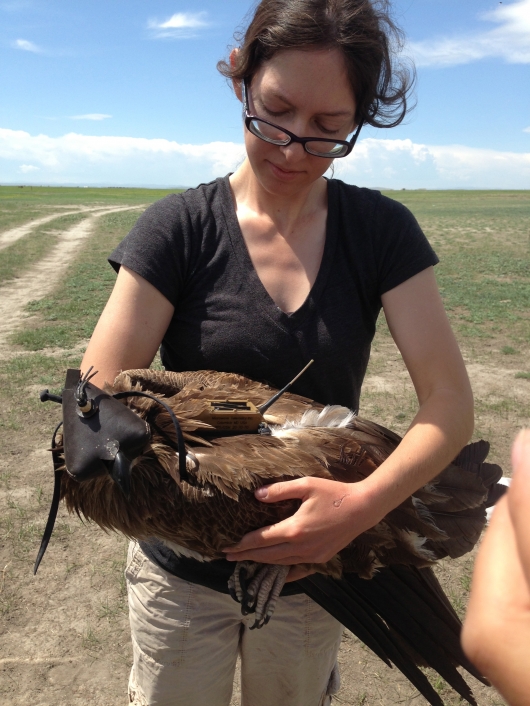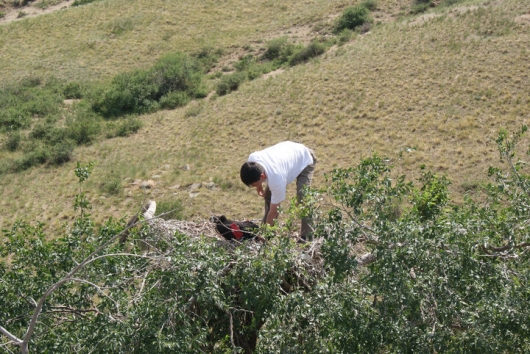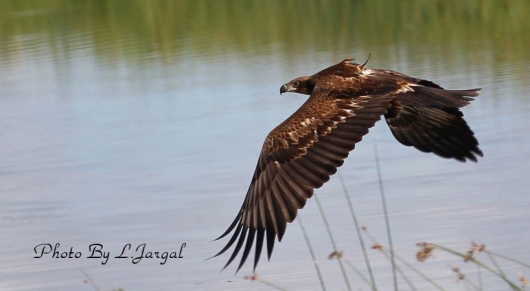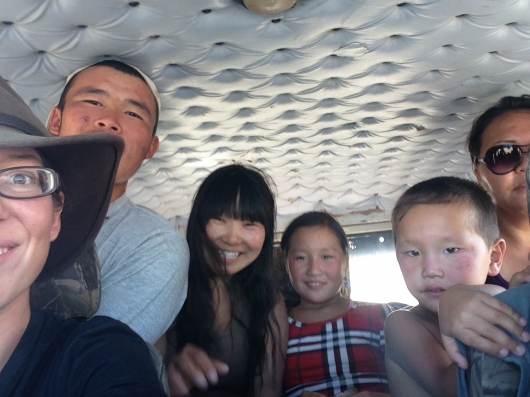Journey of the Pallas's Fish Eagle
Pallas's Fish Eagle (Haliaeetus leucoryphus) is the most poorly studied fish eagle within the Northern Hemisphere, unlike its well-known cousin the American Bald Eagle. Virtually nothing is known about the species' non-breeding habitat requirements. Even worse, there has never been a study examining the seasonal movements of this elusive bird. My team is the first to ever conduct an extensive migration study on Pallas's Fish Eagle. In the past year, we have tagged three Pallas's Fish Eagles with GSM-GPS transmitters. This technology will track the birds by satellite and allow us to see their location up to every 1-5 minutes with an accuracy of up to 18 m! "Chinggis" our first Pallas's Fish Eagle from Mongolia has already traveled over 1,500 miles across Asia this previous fall. The remaining two birds, "Durga" and "Lachit", were tagged this February in India, and we are eagerly awaiting their results. Now, we hope to take this a step further. Our goal is to implement at least two more transmitters this summer in Mongolia, but we need your help. Each satellite unit costs $3,600.00 and GSM data collection is 30.00 a month per unit. In addition, international and in-country travel costs can accumulate to over $5,000.00 a season. Your support for this project is crucial to its success! Even if you are unable to donate, spreading the word about this overlooked, but magnificent bird, is also extremely beneficial to our goals.

Read More About Our Work Here: http://newswire.uark.edu/articles/21002/u-of-a-res...
And Here: http://aviewfromthebackroads.com/?p=1719
The Full Story
Pondering what I wanted to spend the next five years of my life studying as a graduate student in biology, I came across the book, Raptors of the World by James Ferguson-Lees and David Christie. While reading the section on Pallas’s Fish Eagle, a close relative of the Bald Eagle, I became puzzled by something I had never seen before: a home range map covered in question marks. As I continued to seek out more information, it became apparent little was known about this majestic bird. What is known is disparaging.
Prior to the 1900’s, Pallas’s Fish Eagle were common throughout a large portion of Asia, extending west to east from the Caspian Sea to China, and north to south from Russia to India and Myanmar. Now, the species is extinct in Myanmar, Russia, and along the Caspian Sea. Loss of habitat and prey, human disturbance, and agricultural chemicals are believed to be responsible for the severe drop in population over the past 100 years. Virtually nothing is known about the species' non-breeding habitat requirements. Even worse, there has never been a study examining the seasonal movements of this elusive bird.
With a new sense of purpose, I contacted Dr. Sundev Gombobaatar (Dr. Gomboo), whom I met while presenting my undergraduate research on Japanese raptor migration at the Asian Raptor Research and Conservation (ARRCN) meeting in Ulaanbaatar, Mongolia. Could I convince him to help me research this threatened species and potentially save species for future generations? To my relief, he supported my interest. We began to plan the study. Upon further reading, I realized that the eagles in the Mongolia and India breed at completely opposite times of the year. Dr. Gomboo and I concluded that the Indian eagles might be a completely separate population with their own unique breeding and migration habits. In order to understand these perplexing creatures, we needed help.

In January 2012, I ventured to India in search of Pallas's Fish Eagles to complete a few initial surveys in several protected national parks in India. As I continued to discuss my concerns and inquire about the Pallas's Fish Eagle, I was introduced to Dr. Vibhu Prakash, Director of the Pinjore Vulture Breeding Center and former Principal Scientist of the Bombay Natural History Society (One of India’s oldest, publishing scientific societies). Dr. Prakash studied Pallas's Fish Eagle for his Master's work. Upon hearing our proposal, Dr. Prakash agreed to work with us on behalf of the Bombay Natural History Society, thus providing the final integral link to the project. This was the the beginnings of an exciting partnership between four different organizations from three different countries. Through multinational cooperation, it would be possible to study the daily movements of Fish Eagle with GSM-GPS transmitter backpacks.

The next challenge would be to fund the purchase of two GSM-transmitters. Through grants and individuals' generosity, I was able to purchase two transmitters at $3,500 a piece. I can't tell you how nervous I was boarding the plane to Mongolia having my transmitters and gear with me. Neither the trapping mechanisms nor the transmitters had ever been tested on a Pallas's Fish Eagle. Would I be able to find and capture two Pallas's in the brief time that I would have there? The bird had never been caught.
Throughout the month, I would constantly watch the traps. Several birds flew in but were quickly scared off by area activity, such as goat herds passing through. My team and I had our first success July 4, 2013. We finally caught a juvenile Pallas's Fish Eagle. My team and I sprung into action! The transmitter and harness were attached to his back after painstaking measurements, photographs and a banding. I couldn't wait to contact my sponsor and let them know. They needed to name their adopted eagle.
This last February, I embarked on my second field season to the far, northeastern corner of Assam, India. There, members of the Bombay Natural History Society and myself trapped and tagged two Pallas's Fish Eagles from the UNESCO World Heritage Site, Kaziranga National Park. Kaziranga National Park was a whole new set of challenges and adventures. Day-to-day issues included traps being trampled by elephant herds, looking out for tigers, and avoiding rhino charges. Yet, despite all trials, we managed to successfully fit two Pallas's Fish Eagles "Durga" and "Lachit" with their own GSM-GPS backpacks. As of now, we eagerly await their impending migration and the world's first look at their yearly journey.
The project is an international partnership between researchers from the University of Arkansas, India’s Bombay Natural History Society, the Mongolian Ornithological Society, and the National University of Mongolia.
How The Funds Will Be Used
The Challenges
 To achieve our goals, my team and I will be required to spend weeks in the wilds of Mongolia by primitive camping and living alongside the nomadic herdsmen. Over the past two years, we have dealt with blistering heat, electrical storms, trap interference from roaming livestock, sand storms, and transportation issues. However, we have overcome every obstacle through enthusiasm and dedication.
To achieve our goals, my team and I will be required to spend weeks in the wilds of Mongolia by primitive camping and living alongside the nomadic herdsmen. Over the past two years, we have dealt with blistering heat, electrical storms, trap interference from roaming livestock, sand storms, and transportation issues. However, we have overcome every obstacle through enthusiasm and dedication.
The rule of the Mongolian Back country is to work together with your fellow herdsman and if you can't buy it, make it. This rule has been implemented over the years with finger casts, toilets, and jeep axles. We have also had the privilege to live and work alongside the nomadic families that return to our trapping site every year. We have helped each other with tasks as simple as transportation to town or as adventurous as horse herding.

Every bit counts! Donate $5.00 and receive a personal thank you on the project's website and twitter feed. We've had over 500 views and if every viewer donates $5.00 that would pay for over two years of data collection for a transmitter!
You could be the proud owner of your own custom-crafted "Sounds of Mongolia" ringtone. We will record sounds of the Mongolian wilds and convert it to a Iphone compatible ringtone or .wav file just for you!
A high quality printed photograph of a Pallas's Fish Eagle direct from the field season. Great for framing!
Have you ever wanted to receive a postcard from an eagle in some distant land? Now you can!
Adopt an eagle and receive bi-yearly reports of your bird's amazing journey for two years! Teachers: If you would like to develop a lesson plan with the report, I would be happy to work with you. You will also receive a postcard from your eagle.
Sketching and biological illustration in the field is an integral aspect of biology, just ask John James Audubon or George Miksch Sutton! You could receive a personally signed print from one of the researchers' field notes, in addition to the postcard, and the bi-yearly report.
With the complete funding for one of the satellite transmitters, you will get to name the eagle wearing it and be acknowledged in a scientific publication! The name will be used in the bi-yearly reports and during data collection. You will also receive a signed field sketch, a ringtone, a bi-yearly report, a photograph, AND a postcard from your eagle.